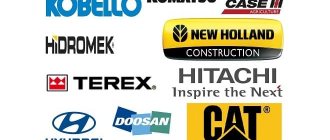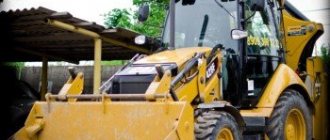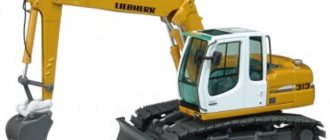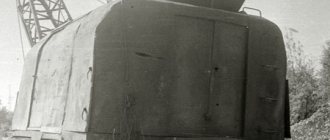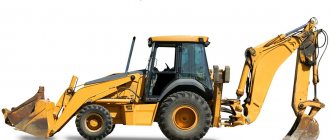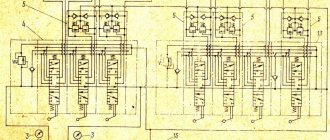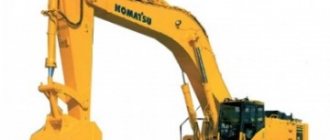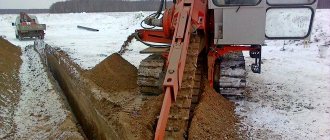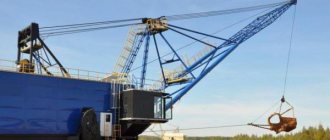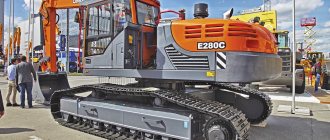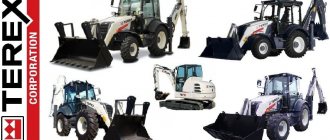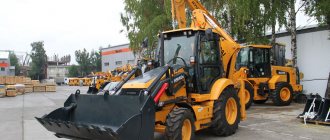Excavators
CATERPILLAR is an American brand that is the hallmark of high-quality and multifunctional construction equipment. The history of this company began back in 1890, when two talented engineers Daniel Best and Benjamin Holt, who conducted the first experiments with steam engines. The result of the work was the appearance of the first steam-powered tractor in history. The inventors did not stop there and already in 1906, the first tractor with a caterpillar propulsion unit appeared, which was equipped with a gasoline power plant. Currently, CATERPILLAR is one of the leading players in the global construction equipment arena, supplying its products to 50 countries. It is noteworthy that the company has representative offices on all continents and has more than 480 divisions.
CATERPILLAR wheeled excavators are designed to perform work in any climatic conditions. The equipment has a well-thought-out layout; accordingly, all the main components and mechanisms are freely accessible, which greatly simplifies repair and maintenance. It is noteworthy that the equipment is unified, so problems with spare parts usually do not arise.
Caterpillar crawler excavators
One of the latest developed models from the manufacturer is the Caterpillar 320 DL crawler excavator. This model is considered a very reliable and safe machine that is easy and simple to operate. The Caterpillar 320DL excavator features a hydraulic system that improves productivity and makes it easy to operate. The equipment becomes universal thanks to the attachments that are offered for it: clamshell bucket, hydraulic hammer, backhoe, etc.
The Caterpillar excavator is a very massive machine with metal tracks. Each track frame has sprockets to adjust the belt tension.
An arm extends from the handle of the excavator, at the end of which a capacious bucket is installed. Since the machine body rotates at a certain angle, the bucket and boom are able to move freely.
The excavator operator's cabin is thought out to the smallest detail: an air conditioner that creates comfortable conditions for working in any weather, a comfortable interior and a convenient panel that simplifies the operation of the excavator. All of these elements improve productivity.
The Caterpillar 320 wheeled excavator was produced from 2006 to 2013, after which its production was suspended and other models began to be produced.
Caterpillar compact excavators have a compact design. They are used when performing earthmoving work, since the main working element of the machine is the bucket.
Due to its small size, the Caterpillar 305E2 CR mini excavator is successfully used in places with limited space. It has all the properties of large models, and its small dimensions are its advantage.
Specifications:
- Total weight - 5185 kg.
- The standard handle length is 1350 mm.
- Extended handle - 1750 mm.
- Digging depth - 3.28 m.
- The width of the caterpillar is 40 cm.
- Travel speed is 4.4 km/h.
- Engine model - Cat C 2.4.
The Caterpillar 330DL unit is a large excavator model with high productivity. It was released in 2008. The manufacturer improved its carrying capacity, increasing it by 5%. This means that the machine remains stable throughout the entire work process. The developer succeeded in this by strengthening the spring system, which resulted in reduced pressure on the chassis of the vehicle.
The Caterpillar 330 consumes fuel economically. This is facilitated by the ACERT technology used in the engine. Power - 247 hp. Travel speed is 5.5 km/h.
The manufacturer recommends using original Caterpillar spare parts to keep the equipment functioning for many years. To do this, he offers a catalog of spare parts, in which they are numbered according to car models.
Advantages of wheeled excavators
The range of CATERPILLAR wheeled excavators is quite diverse. When developing new modifications, the company's designers carefully analyze the needs of modern construction, creating simple and functional equipment designed to perform a full cycle of assigned tasks, without the involvement of other machines. This is how the SMARTBOOM and RIDE CONTROL working body control systems and adaptive hydraulics appeared. Attention is also paid to operator comfort, as evidenced by cabs with panoramic glazing and ROPS protection. The interior space is laid out quite competently, there are heating and ventilation systems, the working parts are controlled using joysticks that are integrated into the armrests of the chair.
An interesting solution is the automatic READY-TO-DIG option, which locks the axles and activates the hydraulics and braking system. This feature helps prepare the machine for work and reduces operator fatigue by eliminating the need to constantly apply the brakes. Another useful option is TRAVEL-LOCK, which locks the turntable and work equipment into the transport position.
Excavators on pneumatic wheels from CATERPILLAR are designed to perform the following work:
- Form construction pits.
- Dismantle road surfaces.
- Set up trenches for laying utilities.
- Used for the needs of public utilities.
- Build artificial reservoirs.
It is noteworthy that wheeled excavators can optionally be equipped with additional equipment, which significantly expands the scope of their application. The main difference from tracked analogues is the ability to independently get to the place of work.
What engine does Caterpillar have? Quarry excavator.
| E650 | Mitsubishi | C S6B-TA | 280 kW - 375.5 hp | 12.9 l. - 786 cubic meters inch | |
| E450 | Mitsubishi | C 6D22TC | 206 kW - 276.3 hp | 11.2 l. - 680.4 cubic meters inch | |
| 5230 | 3516 EUI | 1096.2 kW - 1470 hp | |||
| 5130B | 3508b EUI | 596.6 kW - 800 hp | 34.5 l. - 2105.3 cubic meters inch | ||
| 5080 | 3406C ATAAC | 319.2 kW - 428 hp | 14.6 l. - 890.9 cubic meters inch | ||
| 385CFS | Caterpillar | C18 diesel with ACERT techonlogy | 395.2 kW - 530 hp | 1800 rpm | 18.1 l. - 1104.5 cubic meters inch |
| 365CFS | Caterpillar | C15 diesel with ACERT techonlogy | 306.5 kW - 411 hp | 1800 rpm | 15.2 l. - 927.6 cubic meters inch |
| 245B Series II | Caterpillar | 3406 | 268.5 kW - 360 hp | 14.6 l. - 890.9 cubic meters inch | |
| 235C | Caterpillar | 3306 | 186.4 kW - 250 hp | 10.5 l. - 640.7 cubic meters inch |
speceps.ru
Classification
Quarry excavators can be classified according to the following criteria:
- Chassis type: crawler, walking.
- Operating principle: cyclic action (single-bucket) and continuous action (rotary).
- Type of engine used: diesel, electric, single-engine or multi-engine.
- Drive type: hydraulic, hydromechanical, mechanical, electric, etc.
When choosing, it is customary to be guided by the principle that it is optimal to load a mining dump truck in 4-6 operating cycles of the excavator used.
Tracked
This type of excavator is divided into several types according to the number of tracks installed on the platform: two-, four- and eight-track. Reverse or direct buckets with a capacity of up to 50 m3 or more are used as working devices.
Photo of a crawler mining excavator
Rotary
These excavators can be crawler or walking. At the end of the boom there is a rotating rotor wheel on which the buckets are mounted. The volume of each of them can reach 6 m3. The boom itself can be either retractable or non-retractable. The rotary and dozer booms can be raised and lowered. The range of action when mining rocks is up to 50 m and up to 25 m in depth.
Bucket mining excavator
This excavator is driven by an electric motor.
Hydraulic
This is one of the most common types of earthmoving equipment used in the extraction of ores and minerals in quarries. These machines are used for loading rocks into vehicles.
Excavators of this type are equipped with direct and reverse types of buckets. Diesel engines or electric motors are installed.
Hydraulic Mining Excavator
Walking
This type of excavator can often be found in stripping operations, in most cases they are equipped with a dragline. They got their name - walkers - from their method of movement. In the working position, the excavator is in contact with the ground using a support frame. When there is a need to change the location, the support “skis” are extended, the excavator is raised on hydraulic supports, moves a certain distance (takes a “step”) and lies back on the frame.
Walking mining excavator
Considering the large weight of such mechanisms, up to hundreds and thousands of tons, this design makes it possible to achieve a low value of ground pressure, which would be impossible when using a caterpillar propulsion unit. The boom length can reach 100 m, and the bucket volume can exceed 100 m3.
Model overview
The line of CATERPILLAR pneumatic wheeled excavators is quite diverse. In addition, some machines served as the basis for the creation of more functional and productive modifications. Therefore, it is impossible to consider all the variations of full-size equipment from this manufacturer in one article. Therefore, we will consider the most iconic models that best highlight the advantages of wheeled excavators from this manufacturer.
Caterpillar 206
You can start your review with the CATERPILLAR 206 model, which has the following technical characteristics:
The excavator is equipped with a MEX boom with an optionally variable number of sections. This feature is typical for the entire series of machines.
Caterpillar 206B FT
Based on this model, a more productive modification for heavy work, the Caterpillar 206B FT, was developed. With similar external parameters, the machine is standardly equipped with a self-produced engine with a performance of 78.3 kW. This led to an increase in the fuel tank: up to 215 liters. The throughput of the hydraulic pump has also increased - 200 liters per minute, versus 186 l/min for the base model.
Caterpillar 212
Another interesting model is the CATERPILLAR 212, which is also available in the 212B FT configuration. The machines are equipped with PERKINS T4.236 and CATERPILLAR 3114 diesel engines with a capacity of 70 and 82 kW, respectively. The structural weight of the excavator is 12,800 kilograms, the bucket volume is 0.95 m3 at the maximum value. The excavator can excavate soil to a depth of 5.4 meters and is equipped with a MEX boom. Given the difference in the power of the power plant, the equipment differs in the volume of the fuel tank and the throughput of the hydraulic pump.
Caterpillar 214
One can also note the model of the CATERPILLAR 214 pneumatic wheeled excavator. Here we can highlight a hydrostatic transmission, dual chassis and two piston hydraulic pumps with a variable displacement. The machine is characterized by the following technical parameters:
- The engine is a six-cylinder PERKINS 6.354.4P with a displacement of 5.8 liters and a performance of 76 kW.
- The nominal volume of the bucket is 0.86 m3.
- Transport speed – 20 km/h.
- Fuel tank volume – 200 l.
- The hydraulic pump capacity is 170 l/min.
Caterpillar 214B and 214B FT
With minor changes, the car came out in two versions: 214B and 214B FT.
You can complete the review with the technical characteristics of the CATERPILLAR 224B model. The excavator can excavate soil to a depth of up to 7 meters. The machine is standardly equipped with a six-cylinder engine of its own production, with a power of 100.7 kW. The fuel tank volume is 330 liters, the hydraulic capacity is 330 l/min.
Distinctive features of Caterpillar mining bucket excavators
Built on extreme-climate, heavy-duty powertrains and hydraulics, CAT tracked vehicles perform well over long periods of use.
The 60XX series equipment is designed with improved ergonomics of the operator's workplace. All conditions for fast and accurate control of the boom and attachments are met: a wide viewing angle is provided, performance indicators and indicators are clearly displayed on the working panel, and manipulators are placed ergonomically.
There is also an optional option to install an additional electric motor in a mining crawler excavator in addition to a diesel one.
CAT bucket excavators for open pit mining are
- Fast work cycle (improved response speed due to hydraulic cylinders of reduced diameter).
- Automatic bucket limiter when positioned at the top point (protection against spillage).
- 5 separate hydraulic circuits: 2 for arm lift, 2 for boom movement and 1 for bucket rotation control.
- Rotating platform on roller bearings with low drive power losses.
- Recovery of turning energy and its return to hydraulic pumps.
- Intelligent hydraulic control (protection against excessive temperatures, control of the minimum oil flow through pumps, automatic reduction/increase of the crankshaft frequency in proportion to the increase in load).
- ACERT electronic air injection and charge control system.
